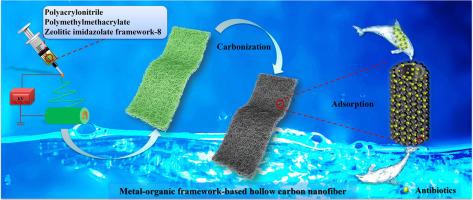采用聚合物共混静电纺丝策略制备层状多孔mof基中空碳纳米纤维垫,高效吸附环丙沙星
IF 6.3
2区 环境科学与生态学
Q1 ENVIRONMENTAL SCIENCES
引用次数: 0
摘要
采用静电纺丝-碳化工艺制备了一种新型多孔金属-有机骨架(MOF)中空碳纳米纤维垫。选择聚丙烯腈/聚甲基丙烯酸甲酯(PAN/PMMA)和多孔咪唑骨架-8 (ZIF-8)两种不混相聚合物作为静电纺丝悬浮液的组成部分。得到的PPZ-CNFM-1-2-2 (PAN:PMMA:ZIF-8 = 1:2:2,质量比)为空心管结构,管壁上有均匀分布的致密空心球。所制备的CNFM具有1696 m2/g的brunauer - emmet - teller比表面积(SBET)和2.74 cm3/g的总孔容,与传统的物理或化学活化方法相当。mof基CNFM对环丙沙星(CIP)具有优异的吸附性能,静态吸附容量约为600 mg/g,仅在1 h内达到吸附平衡。这种优异的吸附能力可归因于其高SBET和丰富的容纳CIP分子的孔,而碳纳米纤维中空心球和空心管结构的存在促进了快速吸附速率。此外,研究还揭示了孔隙填充效应在吸附过程中的重要贡献。固定床实验证实了这种mof基中空CNFM在净化cip污染水方面具有大规模应用的潜力。本文章由计算机程序翻译,如有差异,请以英文原文为准。

Facile preparation of hierarchical porous MOF-based hollow carbon nanofiber mats using a polymer-blend electrospinning strategy for efficient adsorption of ciprofloxacin
A novel hierarchical porous metal-organic framework (MOF)-based hollow carbon nanofiber mat (CNFM) was prepared through a facile electrospinning process followed by carbonization. Two immiscible polymers, polyacrylonitrile/polymethyl methacrylate (PAN/PMMA), and porous zeolitic imidazolate framework-8 (ZIF-8) particles were selected as components for the electrospinning suspension. The resulting PPZ-CNFM-1–2–2 (PAN:PMMA:ZIF-8 = 1:2:2, mass ratio) exhibited a hollow tubular structure with uniformly distributed dense hollow-spheres on the tube walls. The obtained CNFM possessed a high Brunauer-Emmett-Teller specific surface area (SBET) of 1696 m2/g and total pore volume of 2.74 cm3/g, which are comparable to those achieved by traditional physical or chemical activation methods. This MOF-based CNFM demonstrated excellent adsorption performance towards ciprofloxacin (CIP), exhibiting a high static adsorption capacity of approximately 600 mg/g and achieving adsorption equilibrium withing only 1 h. The exceptional adsorption capacity can be attributed to its high SBET and abundant pores that accommodate CIP molecules, while the rapid adsorption rate is facilitated by the presence of hollow-sphere and hollow tubular structures in the carbon nanofibers. Furthermore, the study revealed the significant contributions of pore-filling effect during the adsorption process. Fixed-bed experiments confirmed that this MOF-based hollow CNFM holds great potential for large-scale applications in purifying CIP-contaminated water.
求助全文
通过发布文献求助,成功后即可免费获取论文全文。
去求助
来源期刊

Journal of Environmental Sciences-china
环境科学-环境科学
CiteScore
13.70
自引率
0.00%
发文量
6354
审稿时长
2.6 months
期刊介绍:
The Journal of Environmental Sciences is an international journal started in 1989. The journal is devoted to publish original, peer-reviewed research papers on main aspects of environmental sciences, such as environmental chemistry, environmental biology, ecology, geosciences and environmental physics. Appropriate subjects include basic and applied research on atmospheric, terrestrial and aquatic environments, pollution control and abatement technology, conservation of natural resources, environmental health and toxicology. Announcements of international environmental science meetings and other recent information are also included.
 求助内容:
求助内容: 应助结果提醒方式:
应助结果提醒方式:


